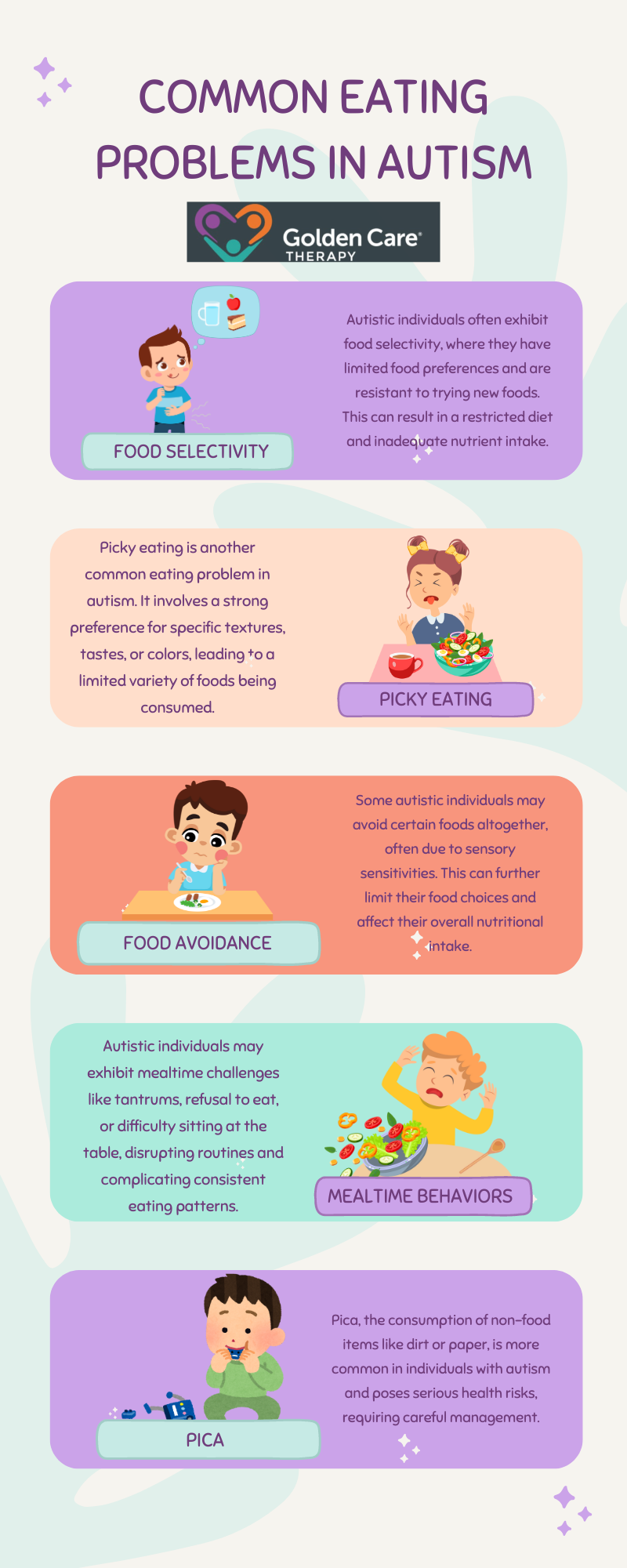Autistic individuals often face unique challenges when it comes to eating, with a range of common eating problems prevalent within this population. These challenges can impact their overall well-being and nutritional intake. Understanding these eating problems is crucial for better supporting individuals with autism.
This guide will explore common eating problems in autismand offer practical tips to help manage them.

Impact of Eating Problems on Autistic Individuals
People with autism often experience eating problems that can have a significant impact on their nutritional intake. These challenges can lead to inadequate nutrient intake, poor diet quality, and potential health complications.
Researchhas shown a strong link between eating problems among autistic individuals. Children with higher average ASD symptom scores tend to have more eating problems from a young age and throughout adolescence.
This suggests that there is a link between the severity of ASD symptoms and the presence of eating challenges.
Interestingly, there is evidence of a bidirectional association between the systems of autism as well as eating problems. Toddlers with higher levels of ASD symptoms are more likely to experience eating problems later on, while early eating problems can also contribute to an increase in ASD symptoms.
This suggests a complex relationship between these two factors, with each potentially influencing the other.
Furthermore, studieshave found that eating problems can have long-term effects on the trajectory of ASD symptoms. Eating problems at a young age may predict a subsequent decrease in ASD symptoms.
This suggests that addressing and managing eating problems in individuals with autism may have a positive impact on their overall ASD symptoms.
It is important to note that the most common feeding issue among autistic youth is food selectivity. Many individuals with autism exhibit limited food preferences and greater food selectivity compared to neurotypical individuals.
This atypical eating behavior can further contribute to the nutritional challenges faced by individuals with autism.
Common Eating Problems in Autism
Eating problems are common in autistic individuals and can manifest in various ways. Some of the common eating problems observed in individuals with autism include:

Understanding these common eating problems in autism is essential for developing strategies and interventions to address and manage these challenges.
Long-Term Effects of Eating Problems in Autism
Eating problems in individuals with autism can have significant long-term effects on their overall well-being. These challenges not only impact their nutritional intake but also have predictive implications for ASD symptoms.
For example, a studyfound that eating problems at 6 years of age predicted a decrease in ASD symptoms at 10 years, suggesting a unidirectional effect of eating problems on subsequent ASD symptoms. This highlights the importance of addressing and managing eating challenges in individuals with autism to potentially mitigate the severity of ASD symptoms over time.
Prevalence of Eating Problems in Autistic Children
Eating problems are more prevalent in autistic children compared to children with other disorders and those in the general population.
Atypical eating behaviors, such as brand-specific preferences and limited food preferences, occur much more frequently in autistic children.
In fact, a sample studyof 1462 youth found that 70.4% of autistic children exhibited atypical eating behaviors, while only 13.1% of children with other disorders and 4.8% of children in the general population displayed similar behaviors.
Among the various feeding issues in autistic youth, food selectivity stands out as the most common problem. Most studies consistently report higher levels of food selectivity in individuals with autism, with limited food preferences being the most prevalent atypical eating behavior.
This can lead to challenges in meeting nutritional needs and may contribute to a higher risk of nutrient deficiencies.
How to Address Eating Problems among Autistic Individuals
In order to address eating problems in individuals with autism, parents and caregivers should approach the challenges with understanding and patience. Following the right strategies for managing eating challenges can help improve the overall eating experience and ensure adequate nutrition.
Here are some effective strategies to consider:
- Create a Structured Mealtime Environment: Establishing a structured mealtime routine can provide a sense of predictability and comfort for individuals with autism. Set consistent meal and snack times, and create a calm and quiet environment to minimize distractions and sensory overload.
- Offer a Variety of Foods: Encourage the inclusion of a wide range of foods in the diet. Introduce new foods gradually, and consider offering preferred foods alongside unfamiliar ones to increase acceptance. Utilize visual aids, such as food charts or visual schedules, to help individuals understand meal choices.
- Respect Food Preferences: Recognize that individuals with autism may have specific food preferences and aversions. Respect their choices and work within their comfort zones while gradually expanding their food repertoire. Seek guidance from a registered dietitian to ensure nutritional adequacy.
- Address Sensory Issues: Sensory sensitivities can significantly impact eating experiences for individuals with autism. Modify the texture, temperature, and presentation of foods to accommodate sensory needs. For example, offering pureed or mashed versions of certain foods for individuals with texture aversions.
- Encourage Mealtime Socialization: Eating in a social setting can positively influence the eating habits of individuals with autism. Encourage family or peer involvement during meals to create a supportive and inclusive environment. Model healthy eating behaviors and provide positive reinforcement for trying new foods.
- Seek Professional Support: If eating problems persist or significantly impact nutritional intake, consider involving a multidisciplinary team of professionals. A registered dietitian, occupational therapist, or speech-language pathologist can provide specialized interventions and support tailored to the individual’s needs.
By implementing these strategies, individuals with autism can develop healthier eating habits and overcome some of the challenges associated with eating problems. It’s important to approach each individual’s needs on a case-by-case basis and be open to adapting strategies as necessary.
Remember, patience, understanding, and support are key to empowering autistic individuals and promoting a positive relationship with food. If you’re looking for the services of ABA centers in New Jersey, New York, Georgia, and Indiana, contact Golden Care Therapy. Reach out to us todayto book a consultation or learn more about our services.



